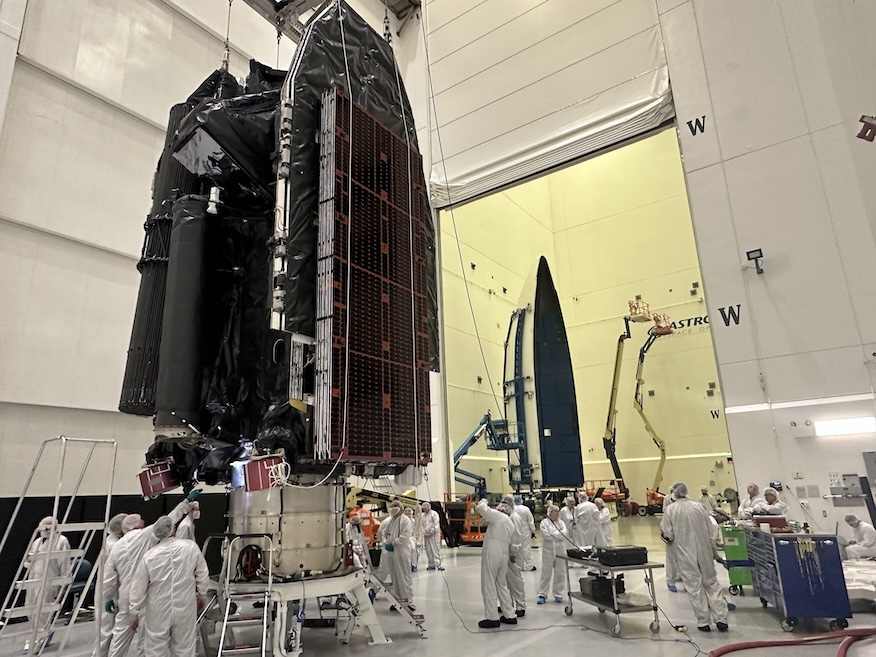Space News & Blog Articles
Live coverage: ULA to launch ViaSat-3 following valve replacement on Atlas 5 rocket
 A United Launch Alliance Atlas 5 551 rocket stands at Space Launch Complex 41 ahead of launching Viasat’s ViaSat-3 Flight 2 satellite to a geosynchronous transfer orbit. Image: Adam Bernstein / Spaceflight Now
A United Launch Alliance Atlas 5 551 rocket stands at Space Launch Complex 41 ahead of launching Viasat’s ViaSat-3 Flight 2 satellite to a geosynchronous transfer orbit. Image: Adam Bernstein / Spaceflight Now
United Launch Alliance is preparing to launch an Atlas 5 rocket Thursday night, which will carry a communications satellite for California-based communications company, Viasat.
The launch comes a week after the mission was scrubbed due to a faulty liquid oxygen tank vent valve on the Atlas booster. ULA rolled the rocket back to the Vertical Integration Facility about third of a mile away, replaced it with a new valve and returned the rocket to the pad on Nov. 12.
The 6-metric-ton satellite will be launched to a geosynchronous transfer orbit, deploying nearly 3.5 hours after the rocket lifts off from Cape Canaveral Space Force Station.
Liftoff from Space Launch Complex 41 is scheduled for 10:04 p.m. EST (0304 UTC), the opening of a 44-minute-long window. The rocket will head due east upon leaving Florida’s Space Coast.
Spaceflight Now will have live coverage beginning about an hour prior to liftoff.
On Tuesday, the 45th Weather Squadron forecast a greater than 95 percent chance for favorable weather during the window. Meteorologist cited no specific weather constraints to liftoff, but did note that there was a “high” chance for interference from solar activity.
“Windspeed has decreased from yesterday and high pressure has settled in over Florida. This high will keep very favorable weather conditions through both the primary and backup launch opportunities,” launch weather officers wrote. “The only watch item is solar activity, with a high risk of X-ray flares and proton flux.”
ULA is launching this mission using an Atlas 5 rocket in its 551 configuration. The 196-foot-tall (59.7 meters) rocket is supported by five solid rocket boosters, which combine with the RD-180 main engine to produce about 2.7 million pounds (12 megaNewtons) of thrust at liftoff.
The SRBs will be jettisoned less than two minutes into the flight, followed by the payload fairings about a minute and a half later. It will take three separate firings of the RL10C-1-1 engine on the Centaur 3 upper stage to reach the correct orbit to release the ViaSat-3 F2 satellite.
Following release, the upper stage will be placed in a so-called graveyard orbit nearly an hour later.
This rocket has the designation of AV-100 and will be the 105th Atlas V rocket launched to date. After this mission, ULA will have 11 of these rockets remaining before it is officially retired:
6 – Boeing’s CST-100 Starliner 5 – Amazon’s Project KuiperWhat’s onboard?
This is the second satellite in the ViaSat-3 series that will operate in geostationary Earth orbit, following the launch of the first spacecraft in 2023. After the ViaSat-3 F1 satellite launched on a SpaceX Falcon Heavy rocket, it suffered an issue with its antenna, which both delayed the start of service and resulted in a reduced capacity.
Viasat officials said ahead of the launch that this new satellite will provide needed Ka-band network capabilities, adding more than 1 terabits per second (Tbps) of capacity to the network over the Americas.
Following a months of on-orbit testing at its operating slog of 79 degrees West longitude, the ViaSat-3 F2 spacecraft is expected to enter service in early 2026.
 The ViaSat-3 F2 satellite is moved within the Astrotech Space Operations facility in Titusville, Florida, where it was encapsulated in payload fairings for United Launch Alliance’s Atlas 5 rocket. Image: Viasat
The ViaSat-3 F2 satellite is moved within the Astrotech Space Operations facility in Titusville, Florida, where it was encapsulated in payload fairings for United Launch Alliance’s Atlas 5 rocket. Image: Viasat
“Beyond an incredible capacity increase, ViaSat-3 F2’s dynamic beam forming capabilities will greatly benefit our customers by efficiently deploying bandwidth to the highest demand places, allowing us to scale performance and the number and density of users,” said Mark Dankberg, Chairman and CEO of Viasat, in a statement. “These capabilities will continue to fuel our successful, multi-orbit service offerings, including service platforms such as Viasat Amara, NexusWave, and a resilient, hybrid SATCOM architecture for government.”
The satellite is built on Boeing’s 702MP+ platform, which uses electric propulsion and solar arrays, the latter of which is from Boeing subsidiary, Spectrolab. Boeing is supporting Viasat in both launch operations and post-deployment checkouts.
“Our goal is to enable missions with reliability and timely delivery,” said Michelle Parker, Vice President of Boeing Space Mission Systems. “With ViaSat‑3 F2, we leveraged proven 702 heritage, advanced power systems and all‑electric propulsion to enable high-speed connectivity for users who rely on it.”
When you subscribe to the SpaceZE News Feed, we will send you an e-mail when there are new updates on the site so you wouldn't miss them.

